Mathematics Olympiad Model Test Paper - 1 | Mathematics Olympiad Class 7 PDF Download
| Table of contents |

|
| Logical Reasoning |

|
| Mathematical Reasoning |

|
| Everyday Mathematics |

|
| Achievers Section |

|
Note: The questions provided in this document are similar to the questions that were asked in the actual Olympiad exam. So, we recommend you study these for your Olympiad preparation
Logical Reasoning
Q1: This graph shows a map of an island just off the coast of a continent. The point labelled B represents a major city on the coast. The distance between grid lines represents 1 km.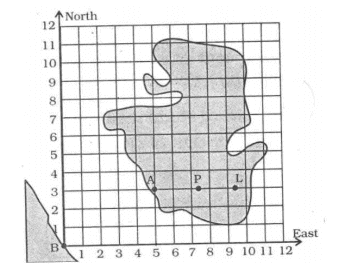
Which point is in the water, (2, 7) or (7, 2)?
(a) (2, 7)
(b) (7, 2)
(c) Both
(d) None of these
 View Answer
View Answer 
Ans: (a) (2, 7)
Q2: Arrange the following words in the order they appear in a dictionary and choose the right option.
(a) 2, 5, 3, 1, 4
(b) 2, 1, 3, 5, 4
(c) 2, 5, 1, 3, 4
(d) 3, 1, 2, 4, 5
 View Answer
View Answer 
Ans: (c)
- To solve this problem, we need to look at the words represented by the numbers and determine their alphabetical order.
- Identify the words corresponding to each number and then arrange them from A to Z.
- After arranging, we find that the correct sequence is represented by option (c) which is 2, 5, 1, 3, 4.
- This means that option (c) correctly reflects the dictionary order of the words.
Q3: If '+' represents '×', '–' represents '÷', '×' represents '+', and '÷' represents '–', what is the result of 115 × 17 ÷ 81 – 3 + 4?
(a) 24
(b) 30
(c) 28
(d) 38
 View Answer
View Answer 
Ans: (a)
- First, we need to replace the symbols according to the given rules:
- 115 × 17 becomes 115 + 17 = 132.
- 132 ÷ 81 becomes 132 - 81 = 51.
- 51 – 3 becomes 51 ÷ 3 = 17.
- Finally, 17 + 4 becomes 17 × 4 = 68.
- However, we need to check the calculations again as we are looking for the final answer.
- After recalculating, we find that the correct final value is 24.
Q4: The smallest number by which 3888 must be divided so that the resulting number is a perfect square is
(a) 2
(b) 6
(c) 3
(d) None of these
 View Answer
View Answer 
Ans: (c)
Resolving 3888 into its prime factors, we find that
3888 = 2 × 2 × 2 × 2 × 3 × 3 × 3 × 3
3888 = (2 × 2) × (2 × 2) × (3 × 3) × (3 × 3) Here we find that prime factor 3 is appearing alone.
Here we find that prime factor 3 is appearing alone.
So, if we divide 3888 by 3, we will get a perfect square number. ∴ 1296 = (2 × 2) × (2 × 2) × (3 × 3) × (3 × 3)
∴ 1296 = (2 × 2) × (2 × 2) × (3 × 3) × (3 × 3)
Q5: The product of two numbers is 1936. If one number is 4 times the other, the numbers are
(a) 16, 121
(b) 22, 88
(c) 44, 44
(d) None of these
 View Answer
View Answer 
Ans: (b)
Let one number = a
∴ Second number = 4
⇒4a×a=1936 ⇒a2=484
⇒a2=484
a2=(2×2)×(11×11)
⇒a=2×11=22
and 4 𝑎 = 4 × 22 = 88
4a=4×22=88
∴ Numbers are 22 and 88.
Q6: The least square number exactly divisible by 4, 6, 10, 15 is
(a) 400
(b) 100
(c) 25
(d) 900
 View Answer
View Answer 
Ans: (d)
Least number which is divisible by 4, 6, 10, 15 is LCM (4, 6, 10, 15)
LCM (4, 6, 10, 15) = 2 × 3 × 5 × 2
LCM (4, 6, 10, 15) = 60
60 = 2 × 2 × 3 × 5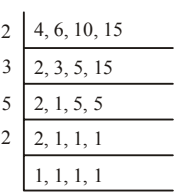
Here we find that 3 and 5 occurs alone. So, if we multiply 60 by
3 × 5 = 15, we get a perfect square number.
∴ 60 × 3 × 15 = 900
900 is the least square number which is divisible by 4, 6, 10, 15.
Q7: 7396 students are sitting in an auditorium in such a manner that there are as many students in a row as there are rows in the auditorium. How many rows are there in the auditorium?
(a) 80
(b) 76
(c) 86
(d) 75
 View Answer
View Answer 
Ans: (c)
Let the number of students sitting in a row = ‘x’
∴ Number of rows in auditorium = ‘x’
∴ Number of students sitting in auditorium
= x x x = x2
Now x2 = 7396 

 Number of rows in auditorium = 86.
Number of rows in auditorium = 86.
Q8: What must be added to 24136 to make it a perfect square?
(a) 100
(b) 200
(c) 111
(d) None of these
 View Answer
View Answer 
Ans: (b)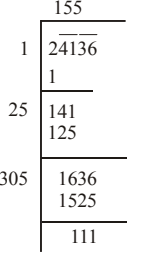
24136 > 1552
∴ Least number must be added to 24136 to make it a perfect square
(156)2 −24136=24336−24136=200
Q9: Find the square root of 0.0196.
(a) 0.10
(b) 0.14
(c) 0.014
(d) 0.0014
 View Answer
View Answer 
Ans: (b)

Q10: Do the points (2, 3) and (3, 2) have the same location on the graph?
(a) sometimes
(b) No
(c) Yes
(d) None of these
 View Answer
View Answer 
Ans: (b) We can clearly see that the location of both points is different.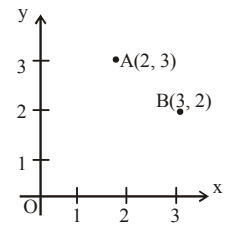
Q11: In the given figure, find the coordinates of A:
(a) (–5, 4)
(b) (5, 4)
(c) (–5, –4)
(d) (4, 5)
 View Answer
View Answer 
Ans: (a)
(–5, 4)
Q12: Find the value of (a) 2
(a) 2
(b) 8
(c) 16
(d) 64
 View Answer
View Answer 
Ans: (c)
As 
Q13: Introducing a woman, Shashank said, "She is the mother of the only daughter of my son." How is the woman related to Shashank?
(a) Daughter
(b) Sister-in-law
(c) Wife
(d) Daughter-in-law
 View Answer
View Answer 
Ans: (d)
- The statement indicates that the woman is the mother of Shashank's son's only daughter.
- This means she is the wife of Shashank's son, making her Shashank's daughter-in-law.
- Thus, the correct relationship is that she is Shashank's daughter-in-law.
- Other options do not fit the relationship described in the statement.
Q14: What least number must be multiplied to 3456 so that the product becomes a perfect cube?
(a) 2
(b) 3
(c) 4
(d) 6
 View Answer
View Answer 
Ans: (c)
Resolving 3456 as a product of prime factors, we get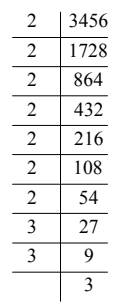

Clearly, to make it a perfect cube it should be multiplied by 2×2=4
Q15: The information given by the graph is: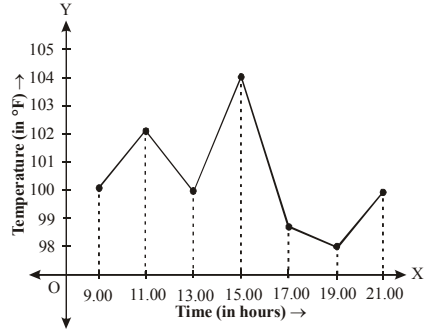 (a) Time-temperature graph
(a) Time-temperature graph
(b) Velocity-time graph
(c) Pressure-volume graph
(d) None of these
 View Answer
View Answer 
Ans: (a)
x-axis shows time (in hours) and y-axis shows temperature (in °F).
Mathematical Reasoning
Q16: Evaluate:
(a) 63
(b) 126
(c) 93
(d) 186
 View Answer
View Answer 
Ans: (b)
So 

Q17: What is the average of the first 8 prime numbers?
(a) 9.625
(b) 8.375
(c) 9.725
(d) 8.675
 View Answer
View Answer 
Ans: (a)
- The first 8 prime numbers are 2, 3, 5, 7, 11, 13, 17, and 19.
- To find the mean, add these numbers together: 2 + 3 + 5 + 7 + 11 + 13 + 17 + 19 = 77.
- Then, divide the total by the number of prime numbers, which is 8: 77 ÷ 8 = 9.625.
- Thus, the mean of the first 8 prime numbers is 9.625.
Q18: The point (3, 4) is at a distance of
(a) 3 from both the axis
(b) 4 from both the axis
(c) 4 from the x-axis and 3 from y-axis
(d) 3 from x-axis and 4 from y-axis
 View Answer
View Answer 
Ans: (c) 4 from the x-axis and 3 from the y-axis.
Q19: The line graph shows the sale of watches in a company. How many watches were sold in those 5 months? 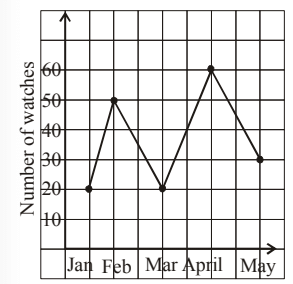
(a) 160
(b) 170
(c) 175
(d) 180
 View Answer
View Answer 
Ans: (d) Total watches sold
= (20 + 50 + 20 + 60 + 30) = 180
Q20: Which of the following numbers should we subtract from 66486.67 to get the predecessor of the smallest 5-digit number?
(a) 56387.53
(b) 56487.67
(c) 48593.28
(d) 43548.48
 View Answer
View Answer 
Ans: (b)
- To find the predecessor of the smallest 5-digit number, we first identify that the smallest 5-digit number is 10000.
- The predecessor of 10000 is 9999.
- Next, we need to determine what to subtract from 66486.67 to reach 9999. This can be calculated as 66486.67 - 9999 = 56487.67.
- Thus, the correct number to subtract is 56487.67, which corresponds to option (b).
Q21: Which of the following values of z will satisfy the given equation?
(a) 5
(b) 3
(c) 6
(d) 4
 View Answer
View Answer 
Ans: (b)
- The equation requires finding a value of z that makes it true.
- Among the options, 3 is the correct value that satisfies the equation.
- To verify, you can substitute each option into the equation and see which one works.
- In this case, 3 is the only value that meets the condition of the equation.
Q22: The value of ( (-17) x (-4) x (-1) x (-5) - (-15) x (-3) x 0 x (-13) x (-11) ) is ______.
(a) 340
(b) 0
(c) -340
(d) 760
 View Answer
View Answer 
Ans: (a)
- First, calculate the first part: (-17) x (-4) x (-1) x (-5). Multiplying these negative numbers results in a positive value.
- Next, the second part: (-15) x (-3) x 0 x (-13) x (-11). Since one of the factors is 0, the entire product equals 0.
- Now, we have: (positive value) - 0 = positive value.
- Calculating the first part gives us 340, so the final answer is 340.
Q23: Class ‘X - A’ of a school collected ₹1024 as contribution to AP flood relief fund. If each student contributed as one student in the class. The number of students in the class are
(a) 24
(b) 32
(c) Can’t say
(d) None of these
 View Answer
View Answer 
Ans: (b)
(b) Let no. of students in the class = x
∴ Contribution of each student = ₹ x
x × x=1024
Q24: The line graph shows that price of chickens in towns M and N. On which days are the price of chickens the same in both the towns?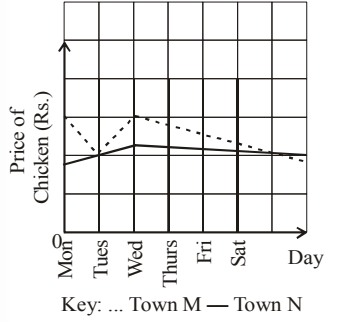
(a) Tuesday only
(b) Friday only
(c) Wednesday and Friday only
(d) Tuesday and Friday only
 View Answer
View Answer 
Ans: (a)
Price of chickens in towns M and N are the same on Tuesday.
Q25: Find the smallest number by which 1152 is divided so that it becomes a perfect square.
(a) 1
(b) 2
(c) 3
(d) 4
 View Answer
View Answer 
Ans: (b) = 2 x 2 x 2 x 3√2 = 24√2
= 2 x 2 x 2 x 3√2 = 24√2
∴ 2 is the smallest number by which 1152 is divided.
Q26: On the Cartesian plane, P, Q, and R are vertices of an isosceles triangle.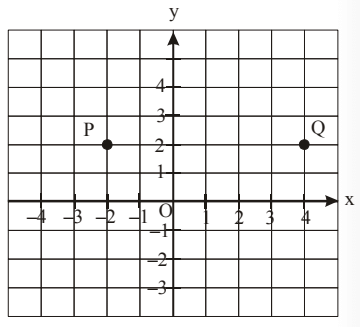
Which of the following are the possible coordinates of R?
(a) (–1, 2)
(b) (1, –2)
(c) (1, 4)
(d) (3, –2)
 View Answer
View Answer 
Ans: (b) Coordinates of R are (1, –2).
Q27: The least number to be subtracted from 24136 to make it a perfect square is
(a) 155
(b) 111
(c) 156
(d) None of these
 View Answer
View Answer 
Ans: (b)
Let us extract the square root from 24136. 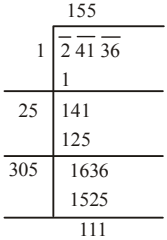 ∴ 24136, is 111 more than (155)2. So if we
∴ 24136, is 111 more than (155)2. So if we
Subtract 111 from 24136, we will get a perfect sq. number.
Q28: The diagram shows a triangle ABC.
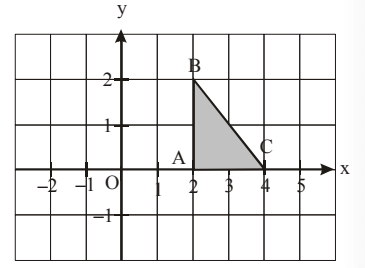
Determine the image of the point C under a reflection in the line AB.
(a) (6, 0)
(b) (4, 2)
(c) (0, 0)
(d) (–2, 0)
 View Answer
View Answer 
Ans: (c)
The coordinates of the point A are (2, 0), and the coordinates of the point C are (4, 0). We can see that line AB lies at an equal distance from the origin (0, 0) and the point C.
Thus, the image of the point C under a reflection in the line AB is the origin, i.e., (0, 0).
Q29: Area of a square field is 22500 m2. A man cycles along its boundary at 15 km/ hr. The time will be taken by a man to return to starting point, is
(a) 2 min 24 sec.
(b) 3 min 12 sec.
(c) 4 mins.
(d) None of these
 View Answer
View Answer 
Ans: (a)
(a) Let the side of the square field = ‘a’ m
∴ Area of square field = a2 sq. m
= a2 =22500 m²
⇒ 𝑎 = 150 m
Speed of cycling = 15 km/hr
∴ 600 m is covered in = 2 min 24 sec.
= 2 min 24 sec.
Q30: A group of students decided to collect as many paise from each member of the group as is the number of members. If the total collection amounts to Rs.22.09, the number of members in the group is:
(a) 37
(b) 47
(c) 107
(d) 43
 View Answer
View Answer 
Ans: (b)
Number of Members
Q31: The diagram is drawn on a Cartesian plane. The x-coordinate of point R is –10.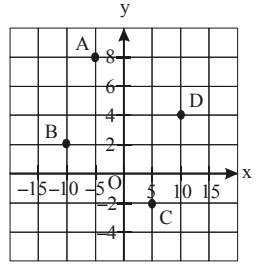
Which of the points A, B, C, and D is likely to be R?
(a) A
(b) B
(c) C
(d) D
 View Answer
View Answer 
Ans: (b)
X-coordinate of point B is –10.
Q32: Name the shape formed by (4, 4), (1, 3), (4, 2), and (7, 3) on the graph paper.
(a) Rhombus
(b) Parallelogram
(c) Rectangle
(d) Square
 View Answer
View Answer 
Ans: (a)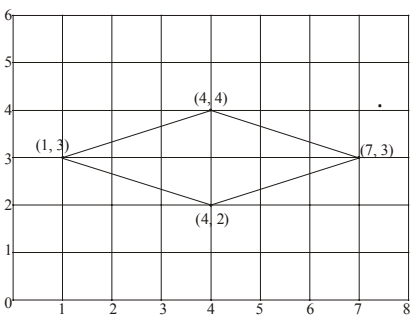
Q33: Which of the following statements is incorrect?
(a) A cone has three faces.
(b) A sphere has one face.
(c) A cube has six faces.
(d) A cylinder has two faces.
 View Answer
View Answer 
Ans: (a)
- A cone has one curved surface and two flat surfaces, making a total of two faces, not three.
- A sphere has one continuous curved surface, which is correct.
- A cube has six flat surfaces, which is also correct.
- A cylinder has two flat circular faces and one curved surface, totaling three faces.
Q34: A perfect square can never have the following digit at ones place.
(a) 1
(b) 6
(c) 5
(d) 3
 View Answer
View Answer 
Ans: (d)
Q35: The line graph shows the monthly expenditure of Vasu family. The total expenditure over the first 3 months is: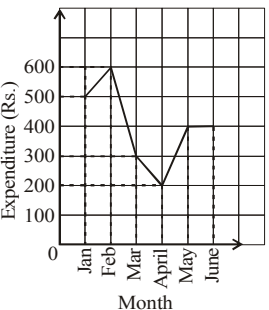
(a) ₹320
(b) ₹600
(c) ₹1100
(d) ₹1400
 View Answer
View Answer 
Ans: (d)
Total expenditure over the first three months
= (500 + 600 + 300) = 1400
Everyday Mathematics
Q36: Aarav starts reading a religious book that contains 1083 pages. He completes 285 pages in the first month and 342 pages in the second month. What fraction of the total pages does he still have to read?(a) 5/17
(b) 8/19
(c) 6/17
(d) 7/19
 View Answer
View Answer 
Ans: (b)
- First, calculate the total pages read by Aarav: 285 + 342 = 627 pages.
- Next, find out how many pages are left to read: 1083 - 627 = 456 pages.
- Now, to find the fraction of pages still to read, divide the remaining pages by the total pages: 456/1083.
- Simplifying this fraction gives us 8/19, which is the correct answer.
Q37: The weekly pocket money (in ₹) of 9 students is as follows: 67, 58, 64, 58, 72, 64, 77, 58, 67. Find the median of the above data.
(a) 77
(b) 72
(c) 58
(d) 64
 View Answer
View Answer 
Ans: (d)
- To find the median, we first need to arrange the data in ascending order: 58, 58, 58, 64, 64, 67, 67, 72, 77.
- Since there are 9 values (an odd number), the median is the middle value, which is the 5th number in this ordered list.
- The 5th number is 64, so the median of the weekly pocket money is 64.
- Thus, the correct answer is (d) 64.
Q38: The smallest number by which 136 must be multiplied so that it becomes a perfect square is
(a) 2
(b) 17
(c) 34
(d) None of these
 View Answer
View Answer 
Ans: (c)
Resolve 136 into prime factors and make group of two of each prime factor
136 = 2 x 2 x 2 x 17 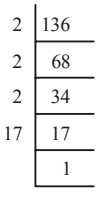 136 = (2 × 2) × 2 × 17
136 = (2 × 2) × 2 × 17
We find that 2 and 17 doesn't appear in group of two. So, 136 has to be multiplied with 34 to make it a perfect square.
∴ 136 × 2 × 17 = (2 × 2) × (2 × 2) × (17 × 17)
⇒ 4624 = (2 × 2) × (2 × 2) × (17 × 17)
⇒ Required square root = 2 × 2 × 17 = 68
Q39: In an entrance examination consisting of 180 questions, the distribution of questions in Maths, Science, and English follows a ratio of 5:4:3. What is the percentage of English questions in this test?
(a) 35%
(b) 42%
(c) 25%
(d) 38%
 View Answer
View Answer 
Ans: (c)
- First, add the parts of the ratio: 5 + 4 + 3 = 12 parts.
- Next, determine the number of English questions: (3/12) x 180 = 45 questions.
- To find the percentage of English questions, use the formula: (45/180) x 100 = 25%.
- Thus, the percentage of English questions in the entrance test is 25%.
Q40: One-fourth of a pole is painted red, two-fifths is painted blue, and the remaining 21 m is painted green. What is the total height of the pole?
(a) 40 m
(b) 60 m
(c) 80 m
(d) 90 m
 View Answer
View Answer 
Ans: (b)
- Let the total height of the pole be H meters.
- According to the problem, one-fourth of the pole is red, which is H/4.
- Two-fifths of the pole is blue, which is 2H/5.
- The remaining height, which is painted green, is given as 21 m.
- So, we can set up the equation: H - (H/4 + 2H/5) = 21.
- To solve this, first find a common denominator for the fractions, which is 20.
- Rewriting the equation gives: H - (5H/20 + 8H/20) = 21.
- This simplifies to: H - 13H/20 = 21, or 7H/20 = 21.
- Multiplying both sides by 20/7 gives H = 60 m.
- Thus, the height of the pole is 60 m.
Q41: Three individuals began their morning walk at the same time. Their step lengths are 15 cm, 25 cm, and 30 cm respectively. What is the least distance each person should walk so that they all cover the same distance in whole steps?
(a) 180 cm
(b) 125 cm
(c) 150 cm
(d) 140 cm
 View Answer
View Answer 
Ans: (c)
- The minimum distance they should walk is determined by finding the least common multiple (LCM) of their step lengths: 15 cm, 25 cm, and 30 cm.
- The LCM of these numbers is 150 cm, which means each person will take whole steps to cover this distance.
- For example, the person with a 15 cm step will take 10 steps, the one with a 25 cm step will take 6 steps, and the one with a 30 cm step will take 5 steps.
- Thus, 150 cm is the distance that allows all three to walk in complete steps.
Q42: In a quiz, team A achieved scores of 45, –50, and 75 points in three consecutive rounds, while team B recorded scores of –45, 50, and 25 points. Which team had a higher total score and by what margin?
(a) Team A, 30 points
(b) Team B, 40 points
(c) Team B, 20 points
(d) Team A, 40 points
 View Answer
View Answer 
Ans: (d)
- Calculate Team A's total score: 45 + (–50) + 75 = 70 points.
- Calculate Team B's total score: (–45) + 50 + 25 = 30 points.
- Compare the scores: Team A scored 70 points, while Team B scored 30 points.
- Determine the difference: 70 – 30 = 40 points.
- Conclusion: Team A scored more than Team B by 40 points.
Q43: Ashok traveled to a mountainous region that is 747.585 km away from his home. He covered 84.375 km on a motorbike, 514.260 km by train, and the remaining distance by car. What is the distance Ashok drove in the car?
(a) 152.650 km
(b) 124.750 km
(c) 148.950 km
(d) 134.250 km
 View Answer
View Answer 
Ans: (c)
- To find the distance traveled by car, first add the distances traveled by motorbike and train: 84.375 km + 514.260 km = 598.635 km.
- Next, subtract this total from the overall distance to the hilly area: 747.585 km - 598.635 km = 148.950 km.
- Thus, the distance Ashok traveled by car is 148.950 km, which corresponds to option (c).
Q44. In the diagram, PQRS is a parallelogram.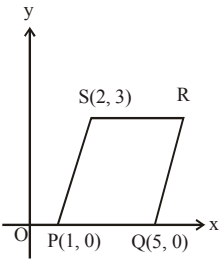
The coordinates of R are
(a) (5, 2)
(b) (5, 3)
(c) (6, 2)
(d) (6, 3)
 View Answer
View Answer 
Ans: (d)
Opposite sides of the parallelogram are equal.
Length of PQ = (abscissa of Q) – (abscissa of P)
= 5 – 1 = 4
Thus, the length of SR = 4
⇒ Abscissa of R is 6
Ordinate of R from X-axis = 3
Thus, the coordinates of R are (6, 3).
Q45: In a gathering, the ratio of males to females was 7:9. Determine the total count of males and females, given that the number of males was 16 fewer than the number of females.
(a) 112
(b) 144
(c) 128
(d) 96
 View Answer
View Answer 
Ans: (c)
- Let the number of males be 7x and the number of females be 9x, based on the ratio.
- According to the problem, the number of males is 16 less than the number of females: 7x = 9x - 16.
- Simplifying this gives: 2x = 16, so x = 8.
- Now, the total number of males and females is 7x + 9x = 16x = 16 x 8 = 128.
Achievers Section
Q46: Read the given statements carefully and state ‘T’ for true and ‘F’ for false.
(i) All integers are whole numbers.
(ii) The product of two integers is 140. If one of them is –35, then the other integer is –4.
(iii) –1 is greater than all other negative integers. (a) T F T (b) F T T (c) F T F (d) T T F
 View Answer
View Answer 
Ans: (b)
- Statement (i): This is false because while all whole numbers are integers, not all integers are whole numbers (e.g., negative integers).
- Statement (ii): This is true. The product of –35 and 4 is indeed 140.
- Statement (iii): This is also true. –1 is greater than any other negative integer, such as –2 or –3.
Thus, the correct answer is (b) F T T.
Q47. A general wishes to draw up his 36562 soldiers in the form of a solid square. After arranging them, he found that some of them are left over. How many are left?
(a) 36
(b) 65
(c) 81
(d) 97
 View Answer
View Answer 
Ans: (c)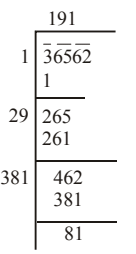
Q48: Read the given statements carefully and select the correct option.
Statement-I: Mukul sells an item at ₹448 and gains a profit of 28%. To gain a profit of 36%, he should sell the item at ₹480.
Statement-II: The marks of a student increase from 35 to 42 in Mathematics. The percent increase in his marks is 25%.
(a) Both Statement-I and Statement-II are true.
(b) Both Statement-I and Statement-II are false.
(c) Statement-I is true but Statement-II is false.
(d) Statement-I is false but Statement-II is true.
 View Answer
View Answer 
Ans: (b)
- Statement-I: To check if Mukul's selling price for a 36% profit is correct, we calculate the cost price first. Selling price at 28% profit is ₹448. The cost price is ₹448 / (1 + 0.28) = ₹350. For a 36% profit, the selling price should be ₹350 x 1.36 = ₹476, not ₹480. So, Statement-I is false.
- Statement-II: The increase in marks is from 35 to 42, which is an increase of 7 marks. The percent increase is (7 / 35) x 100 = 20%, not 25%. Therefore, Statement-II is also false.
- Since both statements are incorrect, the correct option is (b).
Q49: Match the following and select the correct option.
(a) P-(iii), Q-(iv), R-(ii), S-(i)
(b) P-(i), Q-(iv), R-(ii), S-(iii)
(c) P-(i), Q-(ii), R-(iv), S-(iii)
(d) P-(iv), Q-(i), R-(ii), S-(iii)
 View Answer
View Answer 
Ans: (b)
- To solve this question, we need to match the items correctly based on the given pairs.
- Option (b) states that P matches with (i), Q with (iv), R with (ii), and S with (iii), which is the correct combination.
- It's important to carefully analyze each pairing to ensure they align with the criteria provided.
- Thus, option (b) is the right choice as it accurately reflects the correct matches.
Q50: Fill in the blanks and select the correct option.
(a) 60 m², 642 cm²
(b) 80 m², 576 cm²
(c) 70 m², 486 cm²
(d) 80 m², 308 cm²
 View Answer
View Answer 
Ans: (d)
- To solve this problem, we need to analyze the given options.
- Each option presents a pair of values, where the first value is in square meters (m²) and the second in square centimeters (cm²).
- We need to find the correct pair that fits the criteria of the question.
- Option (d) provides 80 m² and 308 cm², which is the correct answer based on the context of the problem.
|
40 videos|118 docs|99 tests
|
FAQs on Mathematics Olympiad Model Test Paper - 1 - Mathematics Olympiad Class 7
| 1. What topics are covered in the Class 7 Mathematics Olympiad Model Test Paper? |  |
| 2. How can I prepare effectively for the Class 7 Mathematics Olympiad? |  |
| 3. What is the format of the Mathematics Olympiad exam for Class 7? |  |
| 4. Are there any recommended resources for practicing Mathematics Olympiad questions? |  |
| 5. How important is participation in the Mathematics Olympiad for students in Class 7? |  |





















